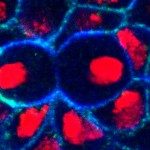Lien vers Pubmed [PMID] – 15124114
Med Sci (Paris) 2004 Apr;20(4):424-30
Several epitheliums exhibit a clear polarity that lies within the plane of the epithelium. This polarity, referred to as planar polarity or tissue polarity, is oriented perpendicular to the apical-basal polarity of the epithelium. Over the last two decades, the genetic and molecular bases of planar polarity have been intensively investigated in Drosophila. Recent studies have shown that establishment of planar polarity relies on the unipolar distribution of a small number of signaling molecules localizing at the apical cortex. Unipolar localization of planar polarity proteins defines two opposite and complementary cortical domains. These domains show a stereotyped orientation at the tissue level. Positioning of these cortical domains is coordinated at the tissue level by a second class of signaling molecules that form an activity gradient across the epithelium. Together these data have led to a general model of planar polarity establishment. Considering that planar polarity genes have been conserved from flies to vertebrates, this model may be useful for our understanding of epithelium biology in mammals.

